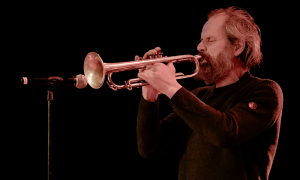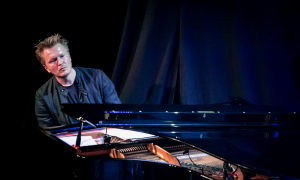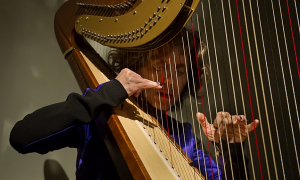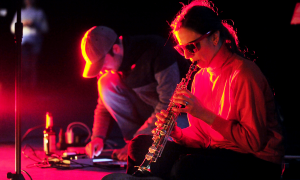Home » Jazz Articles » Festivals Talking » Enjoy Jazz Interviews: Nik Bärtsch
Enjoy Jazz Interviews: Nik Bärtsch

Courtesy Matti Komulainen
In 2020, Bärtsch appeared solo at the Friedenskirche in Ludwigshafen, previewing his Entendre repertoire, from the ECM Records album which was to be released the following year. Bärtsch navigated a rippling rhythmic flow, often with a patterning systems style, influenced by the early times of minimalism. Filaments were turned into fragments, as he struck mallets under the lid, theatrically making zithery flourishes, or creating low bass drones via prepared piano tactics. Once this magical meditation carpet was unrolled, Bärtsch embellished with small percussive hits and trilled clusters. Following an abstract adventure, he would invariably return to a briskly repetitive cycle, sounding like he was improvising in both the abstract and rhythmic realms.
Bärtsch can create a fragile interlacing of rainfall, occasionally broken by thunder or sleet, these effects magnified by a microphone cannily placed under his piano body. He prances across pools with clockwork toes, his refined minimalism revealing hints of a certain cerebral boogie woogie. Bärtsch is an expert at coaxing out multiple simultaneous sounds in different ranges, so fleet is his fingerwork. He exists inside and outside the piano body, at one with his instrument, using the sides of his hands to prepare body-dampened strings instantaneously, always on the move, scraping, trinkling and enunciating at a bewildering rate.
In 2022, Bärtsch is an Artist In Residence at Enjoy Jazz, presenting three new performance concepts at three different venues. "Enjoy Jazz is the festival that supported us the most," Bärtsch recalls. "When we had our first record with ECM, Stoa. Manfred [Eicher] made that connection to Rainer Kern, and he liked the music from the very first moment on, so Rainer gave us the first chance to play, at Karlstorbahnhof, Heidelberg." Kern is the artistic director of Enjoy Jazz, and certainly its dominant figure, also acting as emcee for all of the shows.
"We had a very nice gig, with a piano that went out of tune during the show," Bärtsch laughs. "But the rest was brilliant, and that was the start of the best, longest, most serious, and very creative collaborations I've ever had with a festival, and especially with Rainer Kern as producer."
Bärtsch describes Kern as an "inventive figure." Customarily the pair would decide to present the latest album by Ronin, the pianist's primary group, often prior to its release. "I've tried, over the years, to present different projects," Bärtsch explains. "That started in 2006. There was just one year where we were not there." Of course, he had even played in 2020, a week or so before another lockdown closed the festival prematurely.
This year, Bärtsch will return for another church gig, but this time in Mannheim, bringing along his other outfit, Mobile, now featuring a trio line-up with reedsman Sha and percussionist Nicolas Stocker. "We've done several long concerts with Mobile, but not in this context," says Bärtsch. "Mobile is a band that always creates something that's specifically designed for a place. This new ritual is something special, that we've never done before. We're working in a more spatial fashion. We have four spaces in the church, for an acoustic surround system: two organs, two percussive stations, and the main stage. This has never happened before. It's a special project for the festival."
On October 29th, Mobile will perform Sounding Church Circles at the Christuskirche in Mannheim. The 'ritual' will stretch from 7pm until midnight, encompassing various levels and intensities of performance. The music might have its roots in Mobile's 2016 album Continuum, and there will also be a lighting concept, courtesy of Daniel Eaton. Bärtsch has already visited the church, of course, to absorb its innate qualities, its circular nature, which invites the presence of 'stations' in front of, and behind, the main stage, with what he describes as 'monkish walks' between them. The performance will be completely acoustic. "We'll create a kind of mix between a Morton Feldman ambient piece and some kind of ritualistic voodoo-ish percussion sets. We have some pieces newly developed, but also old patterns that we're working with, this modular concept. Some people that know the music might hear several references."
The main concert will lie at the heart of the evening, where Mobile will present three pieces of new music, described as 'modularly improvised.' "The audience can walk around. They might sit inbetween, but of course, they can also go upstairs to the balconies, and experience from several angles. We'll have an introduction of about an hour, and then another hour of more intense playing, still developing the whole concept. Then we have the main concert, that takes about 60 to 70 minutes. Finally, we have a drifting into the night, towards midnight, that gives the possibility to space out in a more ambient way, to finish the concert."
It will be a listening experience, shaped by light, offering the audience an opportunity to refine their listening awareness: "To let their reception open, and also to experience the church as a musical, acoustically resonating space."
The scenario that Bärtsch describes calls to mind the experience of some Indonesian gamelan performances, where the players are already in motion while the audience arrives, smearing the differences between environment and active public display. The pianist's 'ritual groove' music is sustained by many traditions from around the world, besides Indonesian traditional ceremonies. "It's a universal way of organising acoustic rituals, spaces to experience community, and acoustically dive into our own capacity to listen, and to somehow transcend our normal way of being. Music is one of the most important tools to create that atmosphere."
There will also be solo phases during the performance, with Sha's bass clarinet and contrabass clarinet often played percussively. So too with the prepared piano, lending instruments sounds that often don't exist as expected. Stocker enjoys massaging out some very low bass drum resonances, which sometimes sound electronic, even though in reality the sources are uncompromisingly acoustic.
The first Artist In Residence gig will partner Bärtsch with Les Percussions de Strasbourg, at Alte Feuerwache in Mannheim (October 25th). This is one of the city's prime venues, a converted fire station. The ensemble have been established as modern music specialists for the last 60 years, but their gradual changing shape to a younger generation helps to make their outlook continually contemporary. They have moved from Karlheinz Stockhausen to Steve Reich.
Bärtsch has penned a lot of music for percussion groups, and sometimes his bandmates adopt a heavily rhythmic approach even though they're playing other instruments. Bärtsch doesn't desire a rigid composition-then-rehearsal process, encouraging both sides of this collaboration to maintain an improvisational, malleable nature. "They wanted to build it up over several phases," he says. "To come more into that kind of tribal way of playing, like I work with my own bands. I'm writing music in its very traditional sense, composing in a classical Western manner, but it needs grooves, that are really rehearsed through working and playing a lot."
All the participants wanted to engage in an ongoing process, where music develops organically over time. It's beyond a composition, it's a way of working. A method. "I've composed a whole dramaturgy, let's call it that," Bärtsch elaborates. "And inbetween, it has spatial parts, modular parts, where people have a certain freedom of listening and playing. We know what we're doing, we know where we are, and we have some rules, but the result is, in every space, different."
Around 70% of this Shaker Kami music is predetermined, and the rest is down to the individual ears. The Strasbourg quintet requested that Bärtsch write with specific members in mind, as they tend to possess distinctive styles and approaches. He wanted them to be sonically comfortable. Unusually, there are vibraphones, but no marimbas. Refinements were made in person, by playing together.
The last of these three gigs will feature a duo between Bärtsch and his violinist daughter Ilva Eigus, presenting a fresh repertoire at Alte Aula in Heidelberg (November 6th). Given that she was only born in 2007, Eigus is still in her very early stage of performing, although she has been playing since the age of three. This morning gig will be followed by an interview and discussion.
"I've accompanied her, but more in the classical way," says Nik of Ilva. "But we did one programme with a new piece, and now this next concert will feature the premiere of the full programme. Her background is mainly classical, and I wrote a piece for her last year, which is up to 10 minutes, and there will also be a new duo piece. We also have solo parts. It's a very new programme, stylistically, because it's a combination, and you can hear maybe a bit better my classical background, which is hidden, in Mobile and Ronin."
Bärtsch is still interested in chamber music, and its history, its interpretation as classical music. "I find it especially interesting that when we play together we create a world that's nourished by these different places, and I try to transpose that into the classical chamber music world, without leaving out my rhythmic ingredients."
Bärtsch considers that aspects of Bartok or Stravinsky, often already quite rhythmic, can be developed further via thoughts of minimalism or even post-rock mannerisms. These Enjoy Jazz performances highlight aspects of his composition that will probably be unfamiliar to many of the folks who have witnessed Mobile and Ronin, or more recently, the pianist's solo work. Nevertheless, we can probably guess upon the likely nature of Bärtsch's next few ECM releases...
Tags
PREVIOUS / NEXT
Support All About Jazz
 All About Jazz has been a pillar of jazz since 1995, championing it as an art form and, more importantly, supporting the musicians who make it. Our enduring commitment has made "AAJ" one of the most culturally important websites of its kind, read by hundreds of thousands of fans, musicians and industry figures every month.
All About Jazz has been a pillar of jazz since 1995, championing it as an art form and, more importantly, supporting the musicians who make it. Our enduring commitment has made "AAJ" one of the most culturally important websites of its kind, read by hundreds of thousands of fans, musicians and industry figures every month.

























